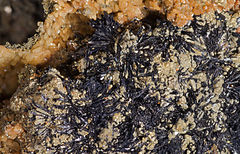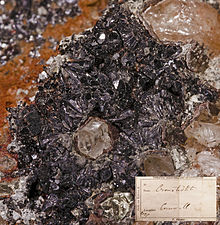- Cronstedtite
-
Cronstedtite 
Cronstedtite - Salsigne Mine - FranceGeneral Category Silicate minerals Chemical formula Fe2+2Fe3+(Si,Fe3+O5)(OH)4 Strunz classification 09.ED.15 Crystal symmetry Trigonal 3m ditrigonal pyramidal Unit cell a = 5.486 Å, c = 7.095 Å; Z = 1[1] Identification Color Black, dark brown-black, green-black Crystal system Trigonal Cleavage Perfect on {001} Tenacity Elastic Luster Sub-Metallic Streak Dark olive green Diaphaneity Translucent Specific gravity 3.34 - 3.35 Optical properties Biaxial (-) Refractive index nα = 1.720 nβ = 1.800 nγ = 1.800 Birefringence δ = 0.080 Pleochroism Visible Dispersion r < v moderate References [1][2][3] Cronstedtite is a complex iron silicate mineral belonging to the serpentine group of minerals. It has a formula of Fe2+2Fe3+(Si,Fe3+O5)(OH)4.
It was discovered in 1821 and named in honor of Swedish mineralogist Axel Fredrik Cronstedt (1722-1765). It has been found in Bohemia in the Czech Republic and in Cornwall, England.
Cronstedtite is a major constituent of CM chondrites, a carbonaceous chondrite group exhibiting varying degrees of aqueous alteration. Cronstedtite abundance decreases with increasing alteration.[4]
References
- ^ a b Webmineral.com
- ^ Mindat.org
- ^ American Mineralogical Society
- ^ Browning et al. (1996) Geochimica et Cosmochimica Acta

This article about a specific silicate mineral is a stub. You can help Wikipedia by expanding it.

